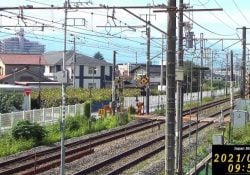Hanami is one of the most anticipated events in Japan, both by Japanese people and tourists visiting the country in spring. It consists of a festival of flower contemplation, mainly Sakura cherry trees.
Índice de Conteúdo
What is Hanami?
Hanami is a traditional Japanese tradition of appreciating the arrival of spring, particularly by watching the cherry blossoms. It is also performed on plum and peach blossoms. Your sub name is Kanou [観桜].
Hanami [花見] literally means “Seeing Flowers” and is one of the simplest and most popular events held in Japan every year. Hanami is a Japanese custom of appreciating and contemplating the beauty of flowers.
It happens when the sakura (cherry trees), umê and other trees begin to bloom and blossom. This event is mainly held in spring between March and May with cherry blossoms (sakura) which is one of the greatest symbols of Japan.
It is traditional not only to look at the flowers alone, but also to hold a feast for large numbers of people to enjoy lunch and sake under the cherry blossoms.
Hanami liqueur, which is drunk while looking at flowers, is very fashionable. In Yin-Yodo, it is interpreted that the shade of cherry blossoms and the sun of feasting are combined. There are more than 300 species of cherry trees and thousands of other flowering trees to enjoy during the festival and other times of the year.
Hanami is not the only event to observe things. In Japan there is the word Tsukimi [月見] literally meaning "moon watching", are Japanese festivals in honor of the autumn moon.
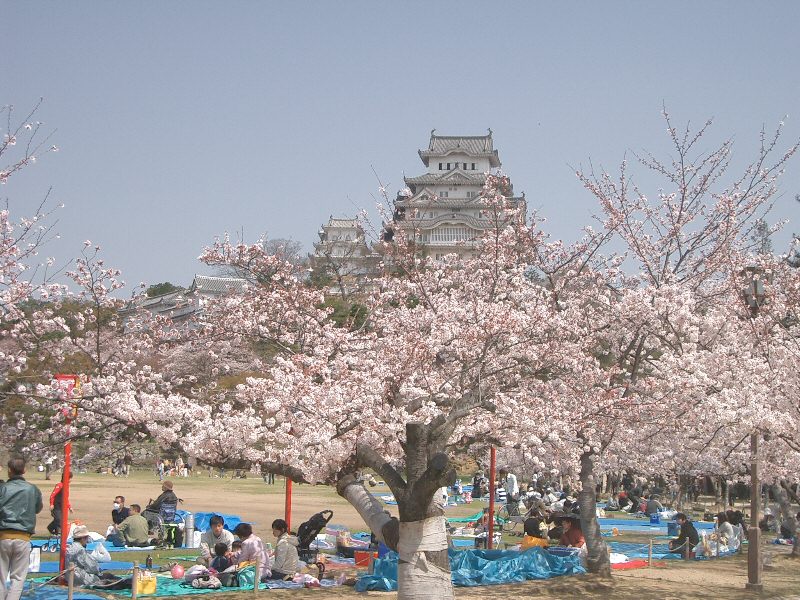
Where to enjoy Hanami?
Where can you enjoy flowers in Japan? Anywhere, in temples, parks, gardens, on the street and in other leisure areas you will find the beautiful sakura blooming.
There are specific places where large numbers of people gather to enjoy the flowers, having picnics under the trees. Castles and their surroundings are also great options for enjoying the cherry blossoms. We have for example the Osaka castle, Himeji, Nijo-jo, Tsuruga, Hirosaki and Nagoya.
Some traders take advantage of this opportunity to set up their stalls, so the Japanese can take advantage and buy several street food, and some items that are only found at festivals.
In Japan, the meaning of flowers differs from the West and even has its own definition and language. We recommend reading our article about it. Hanakotoba and the meaning of flowers.

Flowering regional differences
Cherry blossoms have different flowering times depending on the type and location planted. Expected cherry blossom flowering dates in each region are announced by each particular climate company from February to April each year.
The line connecting the regions predicted to bloom on the same day is called the cherry blossom front. This front is based on Yoshino cherry trees (clones) in various places, so the flowering time varies according to the climate and topography.
However, some cherry trees like Hokkaido Yoshino are used in southern Hokkaido and Sapporo, but in other areas where it does not grow, cherry trees are used. Ezoyama is at Nemuro, where flowering is slow, Chishima cherry trees are used.
On the other hand, in Okinawa, where flowering is early, Kanhizakura is used as the sample tree. Due to differences in latitude, climate and variety, flowering time in Japan is long, from January to May. For more information read our article about Sakura.
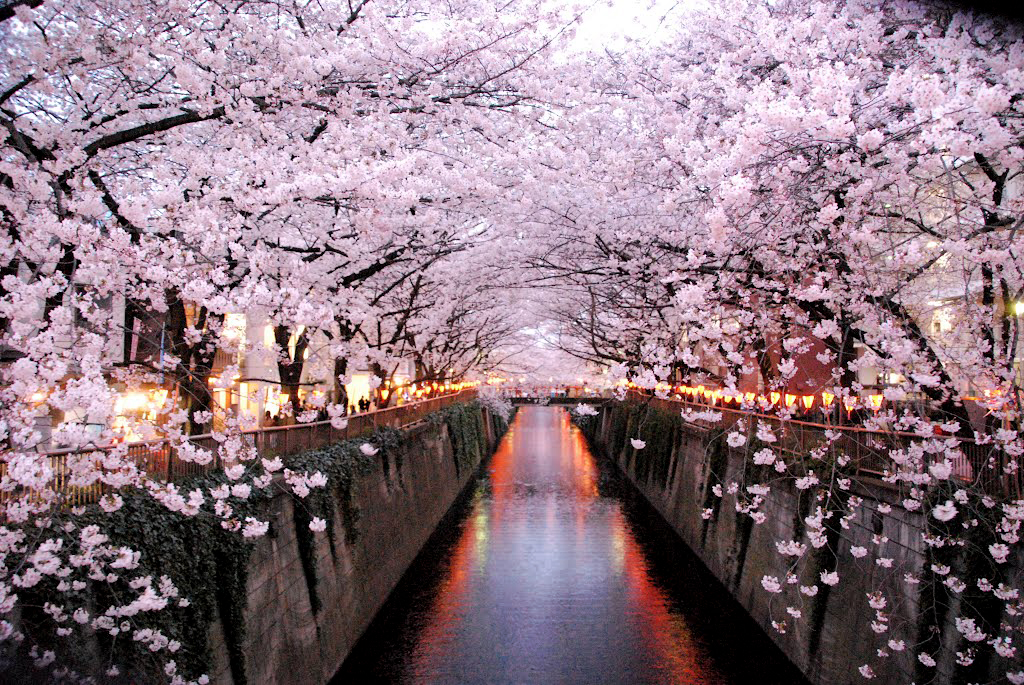
The article is still halfway through, but we recommend also reading:
How to Enjoy Hanami?
Hanami can be considered a matsuri because it involves people meeting, lots of food, drink and music. In certain places the party usually lasts until the night, the hanami at night is called yozakura [夜桜] which means "night sakura".
In many places such as Ueno Park, paper lanterns are raised for these yozakura. Some places such as parks and temples are full, and it is necessary to make a reservation well in advance.
One of the main foods consumed is classic obento and the big candy"Dango". Including that proverb"cookies instead of flowers" (花より団子 Boys Over Flowers) makes fun of people who prefer to eat and drink rather than admire the sakura. It's even the name of a drama that I highly recommend.
Hanami is a very important event as it only lasts from a week to 10 days. That's why, during Hanami, the Japanese arrive in the morning and usually stay all day to enjoy the beauty of the flowers. After such an event, the petals fall to the ground forming a large colored carpet.
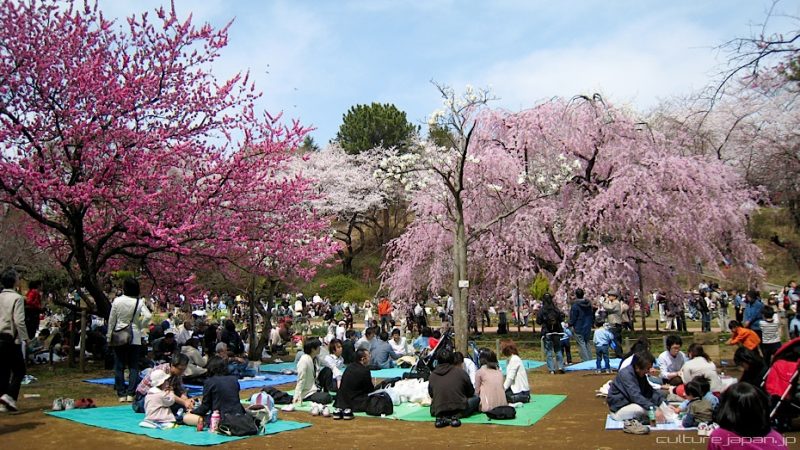
Hanami Rules and Etiquettes
You shouldn't just arrive at the place and do what you want, there are rules to contemplate cherry blossoms, rules that are also applied in the daily life of every Japanese, so they are easy and simple for them to comply with.
Depending on the weather, you can buy some things to help keep your feet warm and other places like kairo. Don't forget to bring a picnic tarp that can be purchased at any grocery store. hyakuen.
Don't pluck the flowers – Do not go around pulling the flowers from the trees looking like a child, that is disrespectful and a great offense. If you want to pick up a Sakura flower, pick up the ones that fall off the ground.
Take off your shoes – Don't think about climbing shoes on the picnic tarp, bring socks to feel more comfortable, but don't get dirty things.
separate the garbage – As usual, you should not leave rubbish on site. Separate, store and take the garbage to your home. The Japan don't usually have trash cans scattered around, then prepare a well-insulated container.
No sound or noise – This festival is a time to enjoy and chat with friends, take off your headphones and don't even think about taking speakers to disturb others, Japan is not Brazil.
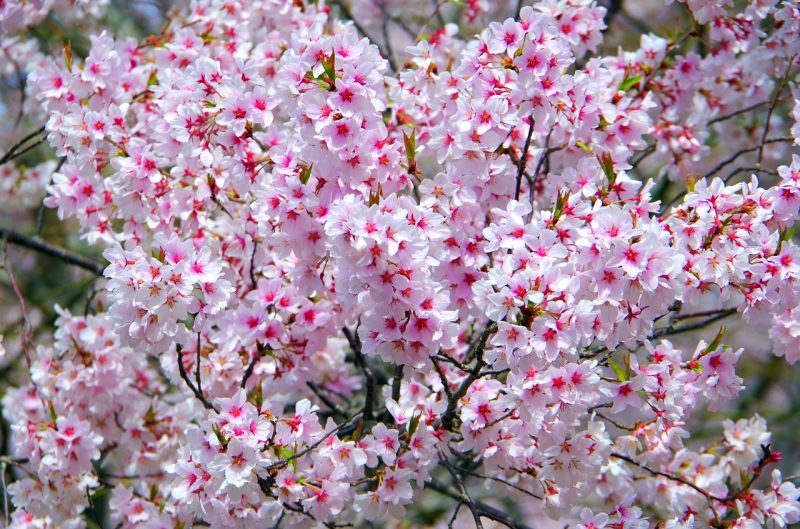
Hanami's history
The practice of hanami It's been done for many centuries. The custom is said to have started during the Nara period (710 – 794) with the flowering of the umê that people admired most in the beginning. There came a time when Sakura gained more importance, even becoming a compliment to women.
In the Heian period (794 - 1185), sakura began to attract more attention than Ume (plum), starting with the haikai poems. Over time, with a few quotes in history, hanami has become one of the most important events of the year.
The first official event was held by Emperor Saga in 812, considered the first cherry blossom display party. The event was held in Jishu Shrine, currently part of the Kiyomizu Temple.

The custom was originally limited to the elite of the Imperial Court, but it soon spread to samurai society and, in the Edo period, to the common people as well. Tokugawa Yoshimune planted areas of cherry trees to encourage this. Under the sakura trees, people ate lunch and drank sake at merry feasts.
The hanami also had religious symbolism. People believed in the existence of the gods within the trees and made offerings from the roots of Sakura trees to help them have good harvests.
Sakura is also considered a symbol of love, in the old days, girls decorated their hair with a sakura branch or decorated their backyard with flowers to show that they were looking for love. Sakura, like roses, has its romantic effects.
Currently the flower has gained a special place in Japanese culture, people from all over the world hold this event, even outside Japan. They are currently portrayed in anime, dramas, stories in addition to being portrayed in the arts as ikebana, kimono and origami.

Hanami videos
Really flowers in Japan are beautiful and have a great meaning in their culture! To finish the article we will leave some videos so you can see the beauty of the flowers and a little of what happens during the hanami.


